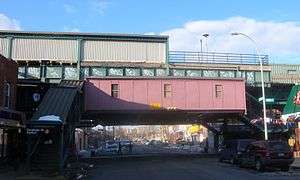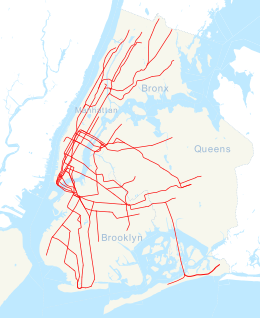Saratoga Avenue station (IRT New Lots Line)
Saratoga Avenue is a station on the IRT New Lots Line of the New York City Subway. Located at the intersection of Saratoga Avenue and Livonia Avenue in Brownsville, Brooklyn, it is served by the 3 train at all times except late nights, when the 4 train takes over service. During rush hours, occasional 2, 4 and 5 trains also stop here.[3]
Saratoga Avenue | |||||||||||||||||
|---|---|---|---|---|---|---|---|---|---|---|---|---|---|---|---|---|---|
 | |||||||||||||||||
| Station statistics | |||||||||||||||||
| Address | Saratoga Avenue & Livonia Avenue Brooklyn, NY 11212 | ||||||||||||||||
| Borough | Brooklyn | ||||||||||||||||
| Locale | Brownsville | ||||||||||||||||
| Coordinates | 40.661531°N 73.915586°W | ||||||||||||||||
| Division | A (IRT) | ||||||||||||||||
| Line | IRT New Lots Line | ||||||||||||||||
| Services | 2 3 4 5 | ||||||||||||||||
| Transit connections | |||||||||||||||||
| Structure | Elevated | ||||||||||||||||
| Platforms | 2 side platforms | ||||||||||||||||
| Tracks | 2 | ||||||||||||||||
| Other information | |||||||||||||||||
| Opened | November 22, 1920 | ||||||||||||||||
| Rebuilt | April 11, 2016 to September 19, 2016 | ||||||||||||||||
| Station code | 347[1] | ||||||||||||||||
| Opposite-direction transfer available | Yes | ||||||||||||||||
| Traffic | |||||||||||||||||
| Passengers (2019) | 1,556,357[2] | ||||||||||||||||
| Rank | 288 out of 424[2] | ||||||||||||||||
| Station succession | |||||||||||||||||
| Next west | Sutter Avenue–Rutland Road: 2 | ||||||||||||||||
| Next east | Rockaway Avenue: 2 | ||||||||||||||||
| |||||||||||||||||
| |||||||||||||||||
| |||||||||||||||||
History
The New Lots Line was built as a part of Contract 3 of the Dual Contracts between New York City and the Interborough Rapid Transit Company, including this station.[4] It was built as an elevated line because the ground in this area is right above the water table, and as a result the construction of a subway would have been prohibitively expensive.[5] The first portion of the line between Utica Avenue and Junius Street, including this station, opened on November 22, 1920, with shuttle trains operating over this route.[6][7] The line was completed to New Lots Avenue on October 16, 1922,[7] with a two-car train running on the northbound track.[8] On October 31, 1924, through service to New Lots Avenue was begun.[8]
From April 11, 2016 until September 19, 2016, Saratoga Avenue and Pennsylvania Avenue were closed for renovation.[9]
Station layout
| P Platform level |
Side platform | |
| Northbound | ← ← ← | |
| Center trackway | No track or roadbed | |
| Southbound | | |
| Side platform | ||
| M | Mezzanine | Fare control, station agent, MetroCard machines |
| G | Street level | Exit/entrance |
This elevated station has two side platforms and two tracks with space for a center track that was never installed.[10] Both platforms are longer than the standard IRT train length of 514 feet (157 m) and have beige windscreens and brown and red canopies with green canopies with green frames and support columns for their entire length except for a small section at the west (railroad north) end. Here, they have waist-high black steel fences with two lampposts and one standard black station sign in white lettering in-between them. The windscreens and canopy frames also have black and white station signs.
The station house had several enamel white-on-navy blue "To Street" porcelain signs directing passengers to the street stairs,[11] one of which also had porcelain signs of the same style at the bottom of the canopy that said, "Interborough Rapid Transit Company: To All Trains."[12] These signs were removed during the 2016 renovation.
Exits
The station's only entrance/exit is an elevated station house beneath the tracks at the extreme east (railroad south) end. Inside fare control, it has a waiting area that allows a free transfer between directions, one staircase to the Manhattan-bound platform and two to the New Lots Avenue-bound one. One of those staircases is built adjacent to the platform instead of directly on it and connected to the station house with a wooden elevated passageway. Outside fare control, there is a turnstile bank, token booth, and three staircases going down to all corners of Saratoga and Livonia Avenues except the northeast one.[13]
References
- "Station Developers' Information". Metropolitan Transportation Authority. Retrieved June 13, 2017.
- "Facts and Figures: Annual Subway Ridership 2014–2019". Metropolitan Transportation Authority. 2020. Retrieved May 26, 2020.
-
- "2 Subway Timetable, Effective November 17, 2019". Metropolitan Transportation Authority. Retrieved January 16, 2020.
- "3 Subway Timetable, Effective November 17, 2019". Metropolitan Transportation Authority. Retrieved January 16, 2020.
- "4 Subway Timetable, Effective November 17, 2019". Metropolitan Transportation Authority. Retrieved January 16, 2020.
- "5 Subway Timetable, Effective November 17, 2019". Metropolitan Transportation Authority. Retrieved January 16, 2020.
- "Nearly 70 Track Miles to Be Added To Rapid Transit Facilities in 1920". Brooklyn Standard Union. December 28, 1919. Retrieved August 14, 2016 – via Fulton History.
- "Differ Over Assessment Plans in Transit Projects: Eastern Parkway Subway and Livonia Avenue Extension the Cause of Bitter Dissension Among Property Owners Uptown". The Daily Standard Union. March 13, 1910. Retrieved August 14, 2016 – via Fulton History.
- "Annual report. 1920-1921". HathiTrust. Interborough Rapid Transit. Retrieved September 5, 2016.
- Cunningham, Joseph; DeHart, Leonard O. (1993). A History of the New York City Subway System. J. Schmidt, R. Giglio, and K. Lang. p. 53.
- "IRT Brooklyn Line Opened 90 Years Ago". New York Division Bulletin. New York Division, Electric Railroaders' Association. 53 (9). September 2010. Retrieved August 31, 2016 – via Issu.
- "The Stations Were Closed for Renewal Work Since April". mta.info. Metropolitan Transportation Authority. September 16, 2016. Retrieved August 28, 2019.
- Dougherty, Peter (2006) [2002]. Tracks of the New York City Subway 2006 (3rd ed.). Dougherty. OCLC 49777633 – via Google Books.
- "To Street" porcelain sign (The Subway Nut)
- IRT "To All Trains" porcelain sign (The Subway Nut)
- "MTA Neighborhood Maps: Brownsville" (PDF). mta.info. Metropolitan Transportation Authority. 2015. Retrieved 19 July 2015.
External links

- nycsubway.org – Brooklyn IRT: Saratoga Avenue
- Station Reporter — 3 Train
- The Subway Nut — Saratoga Avenue Pictures
- Saratoga Avenue entrance from Google Maps Street View
- Platforms from Google Maps Street View



%26groups%3D_ebd2a8eb7af8c2581aa802d6a88d513f560bf4f5.svg)